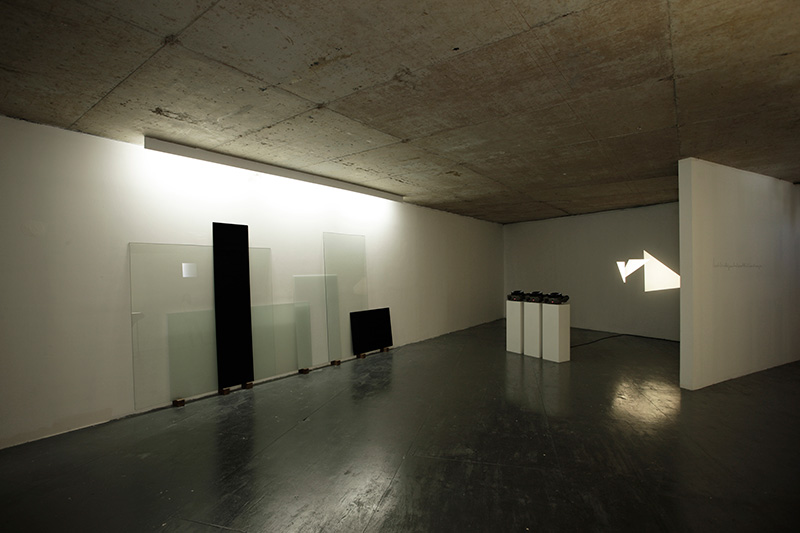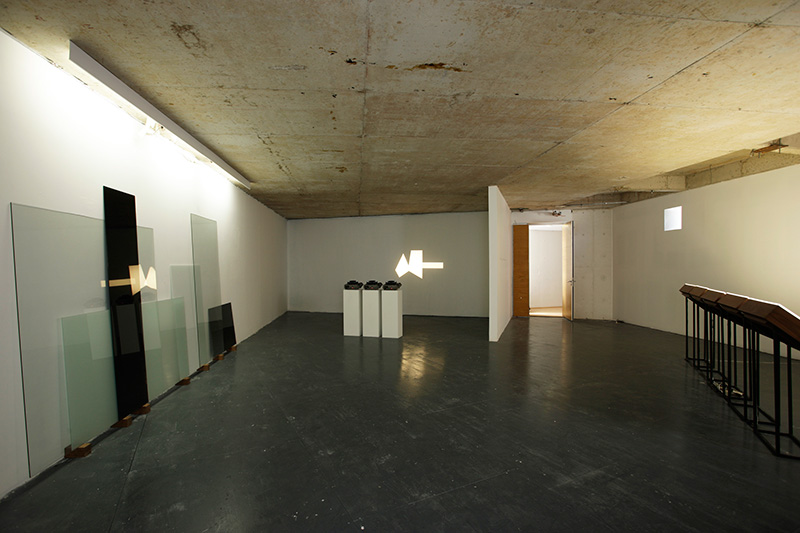Chance Meeting
Curro y Poncho gallery, Guadalajara, Mex.
Photo credit Carlos Díaz Corona.
Exhibition text-
Chance Meeting
January 2010
The austere works of Francisco Ugarte, most of them loaded with silence and stillness, should be taken as reflexive exercises, as an investigation about the potentialities of places and the capacity of the spectator to perceive phenomena and the fragility of their permanence. One should not confuse Ugarte’s reflection with mere contemplation. Instead, it should be understood in the sense in which Merleau-Ponty understood it: a violent exercise. In his works, Francisco Ugarte loans to himself the idea of the “architectural space” on its widest sense: place, site. Afterwards, by means of an intense and meticulous perception work, he deprives it of surroundings and volumes, leaving the space on its most pure state by converting it into light, shadows and reflections.
Nevertheless, the process that Ugarte follows to come close to his idea of site is not purely phenomenological. Although he retakes the the classic Husserlian method, which proposes to momentarily suspend judgment to become closer by means of intuition to the essence of things, Ugarte takes a different path and abandons passive contemplation to start a creative process where the objective is to make us see new situations and discover different possibilities for the same sites. His work not only seeks the essences, it strives for transformation. His regular raw materials, such as sunlight, shadows from the vegetation, different materials that produce light or reflections such as crystals, projectors or mirrors, seek to add properties or variations to the site, creating new reflections, subtle changes in light, new paths or even nostalgic reproductions of close places. All these actions aim to transform our perception or the sites’ essence.
Ugarte’s recent work has been gradually drifting apart from his evident predecessors of Light Art, such as Turell, Flavin or Irwin. Ugarte proposes the title Chance Meeting for this exhibition; this submits us the idea of a fortuitous encounter and gives an advanced notice about the artist’s intention of generating point of contact. In this occasion, Ugarte contains himself within the physical limits of the gallery and introduces different pieces that by means of superimposition (apparently random) of different materials and surfaces and with the help of light, do not create, but merely suggest spaces. The first group of works has base on the creation of bidimensional silhouettes by means of contact between different films or membranes, evoking different skylines of an inexistent city. In other place of the room, he uses different varieties of crystal, with their varied hues and reflections, to create two pieces: one marks a corner (the only site-specific piece in this show); the other one is a hybrid between sculpture and architecture, which apparently constitutes a ready made found on a crystal store.
A series of intervened slides show different geometric shapes. As inheritors of Russian Suprematism of the beginnings of the 20th century, more than seeking pure sensations as their predecessors, what Ugarte’s projections intend, is to create “contact zones”, ephemeral moments of coincidence that take us more to architectural matters rather than any type of abstraction. In this way, Ugarte drifts apart from Malevich and becomes closer to Heidegger’s Of Art and Space, when thelatter asks himself if “the plastic body embodies something, it embodies the space? Is Plastic Art the possession of a space, a container the space?” When we experience a site, we experiment the relationship between oneself and the otherness, with what exists out of us, the contact points between phenomena, experiences and our interior.
William Carlos Williams says that “Place is the only reality, the true core of the universal.” By understanding the particular traits of a place takes to understand our own identity, our own mental space. Ugarte offers anonymous places, un-places that seek to find their identity by means of contact with the “other,” in a particular logic of coexistence and interaction.
Jorge Mendez Blake.





